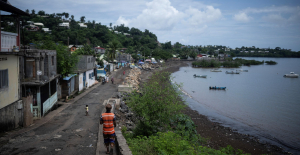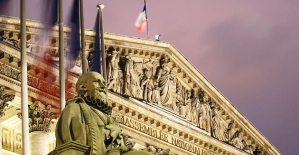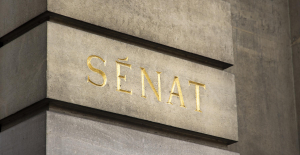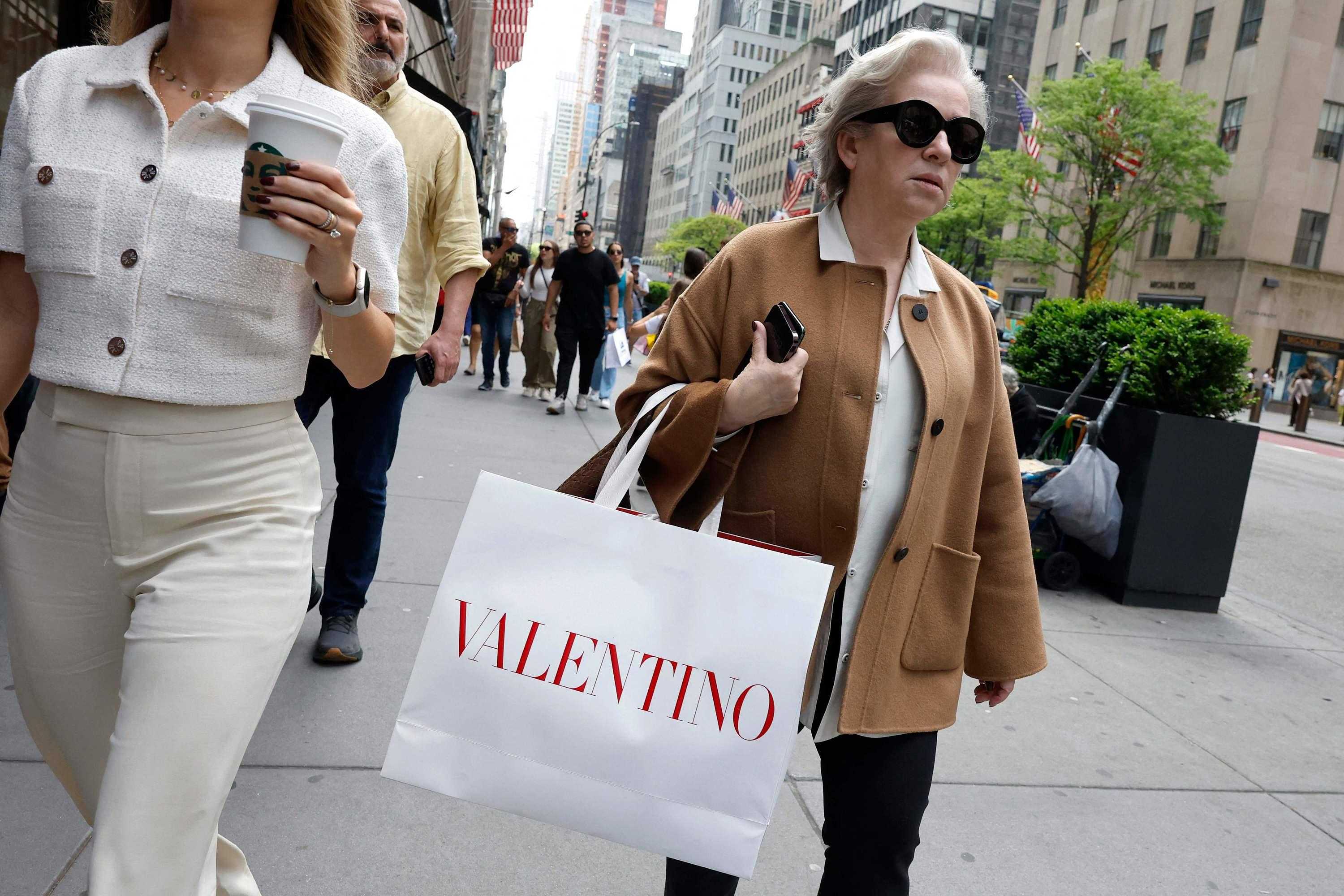A church closed due to cracks, another victim of water infiltration: in Épinay-sur-Seine (Seine-Saint-Denis), as in many municipalities in France, 20th century religious buildings are deteriorating and struggling to finance their renovation. With its bell tower reminiscent of a minaret and its facade with Chinese decoration and its pagoda roof, the Notre-Dame-des-Missions-du-cygne-d'Enghien church is undoubtedly one of the most original in Île-de-France. -France. But the building, built to the glory of the missionary conquest for the 1931 Universal Exhibition, had to close overnight at the beginning of October, cracks raising fears that the porch vaults would collapse. “Experts estimated that it could happen in ten years or within a week,” Jean-Baptiste Dupuis, diocesan treasurer of Seine-Saint-Denis, told AFP.
Also read: When a village transforms its church into an escape game and the chapel into a cabaret
Since then, props have made it possible to reopen the church. A temporary solution before repairs, even if the main building is not a priori threatened: “we already know that it will be hundreds of thousands of euros”, sighs Jean-Pierre Gaspard, general director of Chantiers du cardinal, association which helps the construction and maintenance of religious buildings in Île-de-France.
A little further away is the Saint-Patrice church, facing the towers of the town of Orgemont, which screams misery, the doors wide open to allow the humidity to escape. “The water infiltration is such that the meter broke two weeks ago, with a fire breaking out. The expert told us, you were lucky. But we haven’t dared to turn the heating back on since,” says Father Désiré Zanté, parish priest. A tarpaulin was placed on this square building, with typical concrete from the 1960s. Here too, the bill promises to be staggering, around 400,000 euros.
However, these buildings were built after the 1905 law separating Churches and State: they belong to the diocese of Seine-Saint-Denis which has 72 in total. A challenge in what remains one of the poorest departments in France: “In the quest, here, there are still yellow coins in the basket…”, recalls Father Zanté. These churches will also not be able to benefit from the subscription for religious heritage launched by Emmanuel Macron, intended for municipalities with less than 10,000 inhabitants. “The whole of France is behind the small village churches, and that is very good, but we must not forget these”, built in the 20th century to accompany urbanization, because “they are full and necessary”, underlines Jean-Pierre Gaspard.
Also read: “French religious heritage, our intimate landscape”
Since their founding in 1931, the Chantiers du Cardinal, which live on donations, have built 330 churches - three others are under construction in Chelles, Montigny-le-Bretonneux and Val d'Europe. “A construction costs 10 million euros minimum,” explains Jean-Pierre Gaspard, who notes that with a budget of 4 to 5 million euros annually, his association “has many more needs than resources” . Especially since, with aging donors, a public not always aware of the subtleties of financing post-1905 churches, “we are in a regular decline in the amount of our collection, while our needs are exploding,” he adds. . The crisis of sexual violence in the Church has undoubtedly not helped generosity either.
But renovations remain necessary, while churches are deteriorating, victims of three factors: land subsidence, damage to roofs (which affects around fifty churches in Île-de-France) and crumbling of aging materials. This was the case at the Notre-Dame du Raincy church, a concrete masterpiece created by the brothers Auguste and Gustave Perret, which saw scales coming off the bell tower until its renovation was completed in March.
A large part of the financing came from public subsidies, the building being classified as a “historic monument” – there are only two post-1905 churches in this case in Seine-Saint-Denis, with Notre-Dame-des-Missions. Jean-Pierre Gaspard also welcomes Emmanuel Macron's stated desire to promote the classification of 19th and 20th century buildings. “There is an awareness at the top of the state that the religious heritage of the 20th century is only helped by public generosity,” he believes.

 Gaza: under the spotlight, the Israeli-Palestinian conflict shakes up the Eurovision contest
Gaza: under the spotlight, the Israeli-Palestinian conflict shakes up the Eurovision contest Black soldier killed by a police officer in the United States: the sheriff publishes the video of the arrest
Black soldier killed by a police officer in the United States: the sheriff publishes the video of the arrest In Malmö, the Eurovision party transformed into entrenched camps
In Malmö, the Eurovision party transformed into entrenched camps In Russia, Vladimir Putin stigmatizes “Western elites”
In Russia, Vladimir Putin stigmatizes “Western elites” “Mediterranean diet” or “DASH”, two good tips for eating better
“Mediterranean diet” or “DASH”, two good tips for eating better Fatal case of cholera in Mayotte: the epidemic is “contained”, assures the government
Fatal case of cholera in Mayotte: the epidemic is “contained”, assures the government The presence of blood in the urine, a warning sign of bladder cancer
The presence of blood in the urine, a warning sign of bladder cancer A baby whose mother smoked during pregnancy will age more quickly
A baby whose mother smoked during pregnancy will age more quickly Artificial intelligence lies, cheats and deceives us, and that's a problem, experts warn
Artificial intelligence lies, cheats and deceives us, and that's a problem, experts warn Google Cloud mistakenly deletes UniSuper fund account and deprives 600,000 Australians of their superannuation
Google Cloud mistakenly deletes UniSuper fund account and deprives 600,000 Australians of their superannuation IBM, Amazon, Hager... These record investments expected at the Choose France summit
IBM, Amazon, Hager... These record investments expected at the Choose France summit Boeing's black streak: a second Air France flight diverted in three days for “a smell of heat”
Boeing's black streak: a second Air France flight diverted in three days for “a smell of heat” Brian Wilson, famous singer of the Beach Boys, placed under guardianship
Brian Wilson, famous singer of the Beach Boys, placed under guardianship The Nuc plus ultra: siblings from Australia and the echoes of Nico
The Nuc plus ultra: siblings from Australia and the echoes of Nico In Brighton, an artist shows... her doll's house
In Brighton, an artist shows... her doll's house Hiroaki Samura: “There is universal enjoyment in seeing a weak character prevail over the powerful”
Hiroaki Samura: “There is universal enjoyment in seeing a weak character prevail over the powerful” Omoda 7, another Chinese car that could be manufactured in Spain
Omoda 7, another Chinese car that could be manufactured in Spain BYD chooses CA Auto Bank as financial partner in Spain
BYD chooses CA Auto Bank as financial partner in Spain Tesla and Baidu sign key agreement to boost development of autonomous driving
Tesla and Baidu sign key agreement to boost development of autonomous driving Skoda Kodiaq 2024: a 'beast' plug-in hybrid SUV
Skoda Kodiaq 2024: a 'beast' plug-in hybrid SUV The home mortgage firm rises 3.8% in February and the average interest moderates to 3.33%
The home mortgage firm rises 3.8% in February and the average interest moderates to 3.33% This is how housing prices have changed in Spain in the last decade
This is how housing prices have changed in Spain in the last decade The home mortgage firm drops 10% in January and interest soars to 3.46%
The home mortgage firm drops 10% in January and interest soars to 3.46% The jewel of the Rocío de Nagüeles urbanization: a dream villa in Marbella
The jewel of the Rocío de Nagüeles urbanization: a dream villa in Marbella Diving into the secrets of the National Assembly
Diving into the secrets of the National Assembly Institutions: senators want to restore the accumulation of mandates and put an end to the automatic presence of ex-presidents on the Constitutional Council
Institutions: senators want to restore the accumulation of mandates and put an end to the automatic presence of ex-presidents on the Constitutional Council Europeans: David Lisnard expresses his “essential and vital” support for François-Xavier Bellamy
Europeans: David Lisnard expresses his “essential and vital” support for François-Xavier Bellamy Facing Jordan Bardella, the popularity match turns to Gabriel Attal’s advantage
Facing Jordan Bardella, the popularity match turns to Gabriel Attal’s advantage These French cities that will boycott the World Cup in Qatar
These French cities that will boycott the World Cup in Qatar 6 Hours of Spa-Francorchamps: Ferrari on pole then disqualified, Alpine making progress, Peugeot continues to worry
6 Hours of Spa-Francorchamps: Ferrari on pole then disqualified, Alpine making progress, Peugeot continues to worry Paris 2024 Olympics: Macron “counts on Real Madrid” to release Mbappé this summer
Paris 2024 Olympics: Macron “counts on Real Madrid” to release Mbappé this summer PSG: why the club did not react to the announcement of the departure of Kylian Mbappé
PSG: why the club did not react to the announcement of the departure of Kylian Mbappé MotoGP: Jorge Martin in pole position, Quartararo will start in eighth position in the French Grand Prix
MotoGP: Jorge Martin in pole position, Quartararo will start in eighth position in the French Grand Prix


















